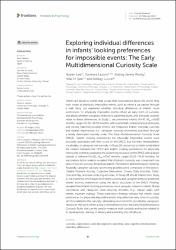Please use this identifier to cite or link to this item:
https://hdl.handle.net/20.500.11779/1976Full metadata record
| DC Field | Value | Language |
|---|---|---|
| dc.contributor.author | Sen, Hilal H. H. | - |
| dc.contributor.author | Lucca, Kelsey | - |
| dc.contributor.author | Lazaro, Vanessa | - |
| dc.contributor.author | Lee, Nayen | - |
| dc.contributor.author | Wang, Jinjing Jenny | - |
| dc.date.accessioned | 2023-10-18T12:06:13Z | - |
| dc.date.available | 2023-10-18T12:06:13Z | - |
| dc.date.issued | 2023 | - |
| dc.identifier.citation | Lee, N., Lazaro, V., Wang, J. J., Şen, H. H., & Lucca, K. (2023). Exploring individual differences in infants’ looking preferences for impossible events: The Early Multidimensional Curiosity Scale. Frontiers in Psychology, 13, 1015649. | en_US |
| dc.identifier.issn | 1664-1078 | - |
| dc.identifier.uri | https://doi.org/10.3389/fpsyg.2022.1015649 | - |
| dc.identifier.uri | https://hdl.handle.net/20.500.11779/1976 | - |
| dc.description.abstract | Infants are drawn to events that violate their expectations about the world: they look longer at physically impossible events, such as when a car passes through a wall. Here, we examined whether individual differences in infants' visual preferences for physically impossible events reflect an early form of curiosity, and asked whether caregivers' behaviors, parenting styles, and everyday routines relate to these differences. In Study 1, we presented infants (N = 47, M-age = 16.83 months, range = 10.29-24.59 months) with events that violated physical principles and closely matched possible events. We measured infants' everyday curiosity and related experiences (i.e., caregiver curiosity-promoting activities) through a newly developed curiosity scale, The Early Multidimensional Curiosity Scale (EMCS). Infants' looking preferences for physically impossible events were positively associated with their score on the EMCS, but not their temperament, vocabulary, or caregiver trait curiosity. In Study 2A, we set out to better understand the relation between the EMCS and infants' looking preferences for physically impossible events by assessing the underlying structure of the EMCS with a larger sample of children (N = 211, M-age = 47.63 months, range = 10.29-78.97 months). An exploratory factor analysis revealed that children's curiosity was comprised four factors: Social Curiosity, Broad Exploration, Persistence, and Information-Seeking. Relatedly, caregiver curiosity-promoting activities were composed of five factors: Flexible Problem-Solving, Cognitive Stimulation, Diverse Daily Activities, Child-Directed Play, and Awe-Inducing Activities. In Study 2B (N = 42 infants from Study 1), we examined which aspects of infant curiosity and caregiver behavior predicted infants' looking preferences using the factor structures of the EMCS. Findings revealed that infants' looking preferences were uniquely related to infants' Broad Exploration and caregivers' Awe-Inducing Activities (e.g., nature walks with infants, museum outings). These exploratory findings indicate that infants' visual preferences for physically impossible events may reflect an early form of curiosity, which is related to the curiosity-stimulating environments provided by caregivers. Moreover, this work offers a new comprehensive tool, the Early Multidimensional Curiosity Scale, that can be used to measure both curiosity and factors related to its development, starting in infancy and extending into childhood. | en_US |
| dc.language.iso | en | en_US |
| dc.publisher | Frontiers Media Sa | en_US |
| dc.rights | info:eu-repo/semantics/openAccess | en_US |
| dc.subject | Knowledge | en_US |
| dc.subject | Epistemic curiosity | en_US |
| dc.subject | Fit indexes | en_US |
| dc.subject | Temperament | en_US |
| dc.subject | Scale development | en_US |
| dc.subject | Awe | en_US |
| dc.subject | Individual differences | en_US |
| dc.subject | Effortful control | en_US |
| dc.subject | Curiosity | en_US |
| dc.subject | Achievement | en_US |
| dc.subject | Young-children | en_US |
| dc.subject | Expectations | en_US |
| dc.subject | Exploration | en_US |
| dc.subject | Childrens questions | en_US |
| dc.subject | Cognitive development | en_US |
| dc.subject | Parenting | en_US |
| dc.subject | Number | en_US |
| dc.title | Exploring Individual Differences in Infants' Looking Preferences for Impossible Events: the Early Multidimensional Curiosity Scale | en_US |
| dc.type | Article | en_US |
| dc.identifier.doi | 10.3389/fpsyg.2022.1015649 | - |
| dc.identifier.pmid | 36817372 | en_US |
| dc.identifier.scopus | 2-s2.0-85148236606 | en_US |
| dc.authorid | Hilal Şen/0000-0002-9877-5108 | - |
| dc.description.PublishedMonth | Şubat | en_US |
| dc.description.woscitationindex | Social Science Citation Index | - |
| dc.identifier.wosquality | Q1 | - |
| dc.description.WoSDocumentType | article | - |
| dc.description.WoSInternationalCollaboration | Uluslararası işbirliği ile yapılan - EVET | en_US |
| dc.description.WoSPublishedMonth | Eylül | en_US |
| dc.description.WoSIndexDate | 2023 | en_US |
| dc.description.WoSYOKperiod | YÖK - 2022-23 | en_US |
| dc.identifier.scopusquality | Q1 | - |
| dc.relation.publicationcategory | Makale - Uluslararası Hakemli Dergi - Kurum Öğretim Elemanı | en_US |
| dc.identifier.volume | 13 | en_US |
| dc.department | İİSBF, Psikoloji Bölümü | en_US |
| dc.relation.journal | Frontiers in Psychology | en_US |
| dc.identifier.wos | WOS:001068305900001 | en_US |
| dc.institutionauthor | Şen, Hilal H. | - |
| item.grantfulltext | open | - |
| item.fulltext | With Fulltext | - |
| item.languageiso639-1 | en | - |
| item.openairetype | Article | - |
| item.openairecristype | http://purl.org/coar/resource_type/c_18cf | - |
| item.cerifentitytype | Publications | - |
| Appears in Collections: | Psikoloji Bölümü Koleksiyonu PubMed İndeksli Yayınlar Koleksiyonu / PubMed Indexed Publications Collection Scopus İndeksli Yayınlar Koleksiyonu / Scopus Indexed Publications Collection WoS İndeksli Yayınlar Koleksiyonu / WoS Indexed Publications Collection | |
Files in This Item:
| File | Description | Size | Format | |
|---|---|---|---|---|
| fpsyg-13-1015649 (1).pdf | Full Text- Article | 5.71 MB | Adobe PDF |  View/Open |
CORE Recommender
SCOPUSTM
Citations
4
checked on Nov 23, 2024
WEB OF SCIENCETM
Citations
3
checked on Nov 23, 2024
Page view(s)
42
checked on Nov 18, 2024
Download(s)
12
checked on Nov 18, 2024
Google ScholarTM
Check
Altmetric
Items in GCRIS Repository are protected by copyright, with all rights reserved, unless otherwise indicated.